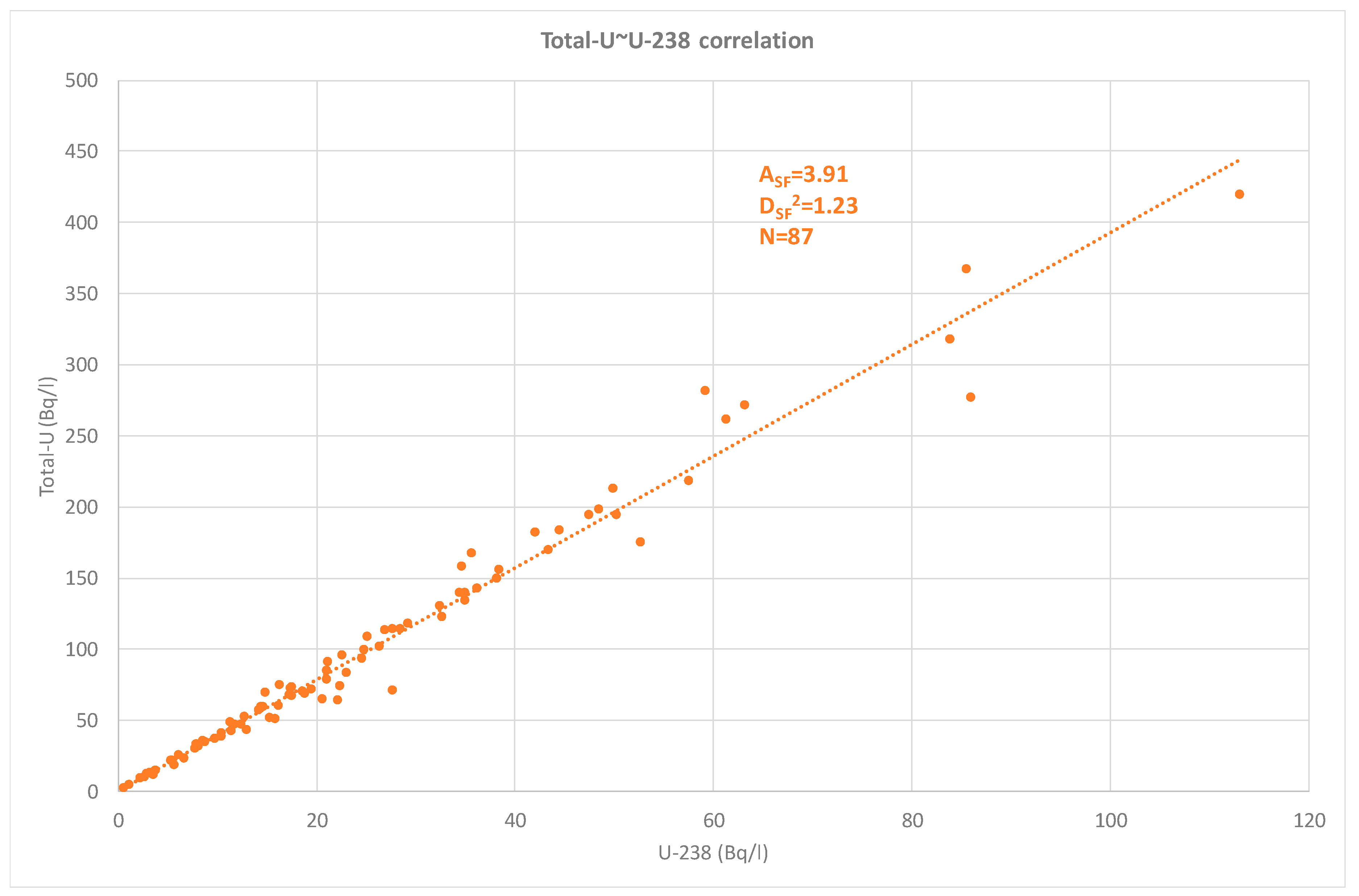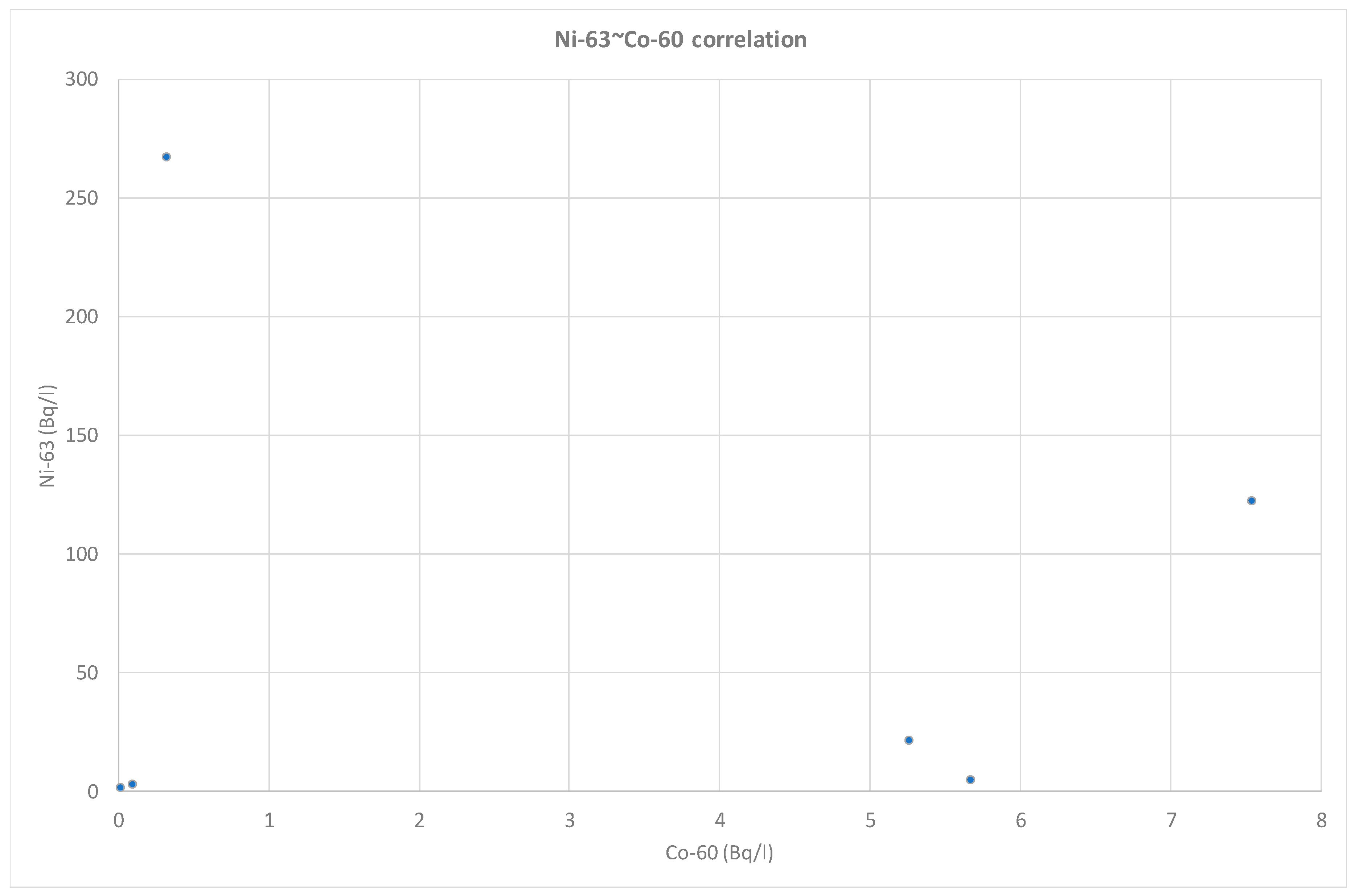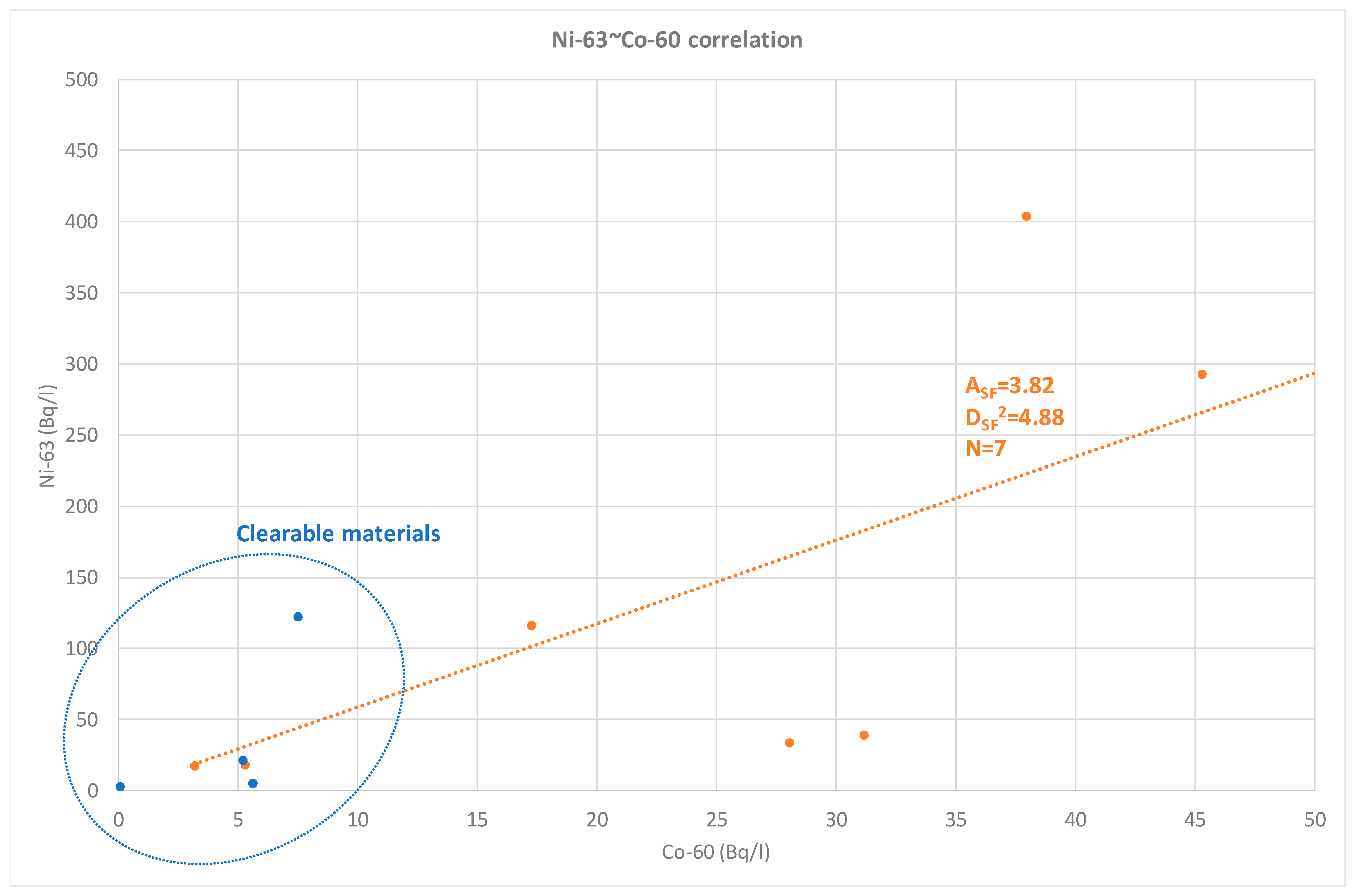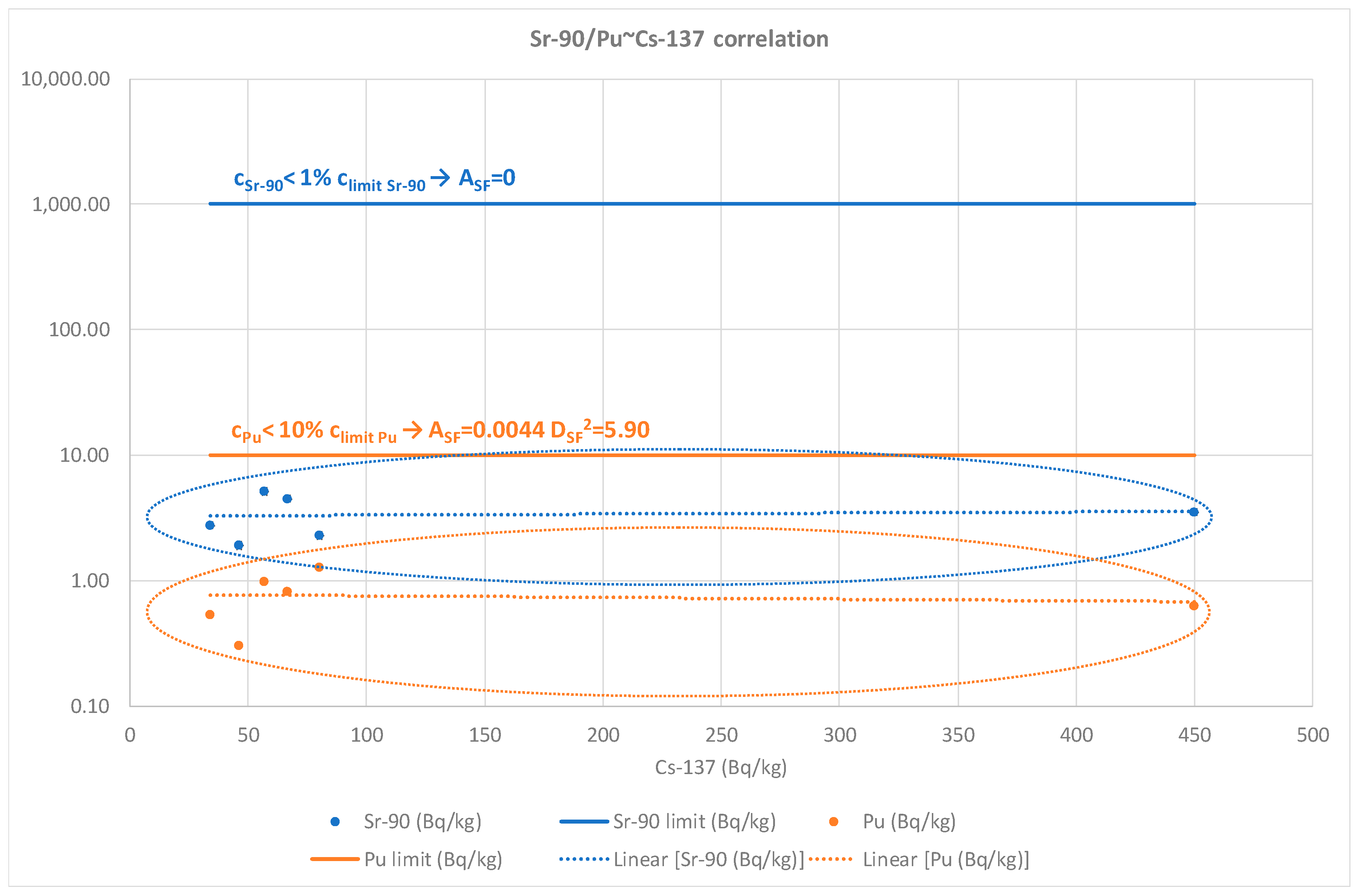Control Experiences Regarding Clearable Materials from Nuclear Power Plants and Nuclear Installations: Scaling Factors Determination and Measurements’ Acceptance Criteria Definition
Abstract
:1. Introduction
2. Materials and Methods
3. Results
- Bosco Marengo “FN” nuclear installation;
- Trino “E. Fermi” nuclear power plant;
- Saluggia “LivaNova” nuclear installation;
- Saluggia “EUREX” nuclear installation.
3.1. Bosco Marengo ”FN” Nuclear Installation Experiences
3.2. Trino “E. Fermi” Nuclear Power Plant Experiences
- In wastes with lower contamination (lot 1), the presence of Cs-137, Co-60, and Ni-63 was observed only in half of the samples, and Sr-90 in a single sample. The presence of alpha emitters was not observed.
- In the wastes with high contamination (lot 3), the presence of Cs-137 was observed beyond the clearance levels (Table 4), Co-60, Ni-63, and Sr-90 in only half of the samples, and alpha emitters in only two samples.
3.3. Saluggia “LivaNova” Nuclear Installation Experiences
- Soil contaminated by radionuclides (regardless of any hydrocarbon contamination) to be managed as cleared materials or, if the relevant clearance levels are not respected, as radioactive waste.
- Soil without any radiological constraints but contaminated by hydrocarbons to be managed as “special” waste.
- Soil not contaminated by either radionuclides or hydrocarbons.
3.4. Saluggia “EUREX” Nuclear Installation Experiences
4. Discussion
- The homogeneity of a clearable lot of material should always be verified with experimental measurements.
- All available information can be useful for the purposes of estimating scaling factors.
- In all samples used to estimate scaling factors, at least one ETM radionuclide must be detectable.
- It is appropriate to define an exclusion level, for example a detection limit – for the detection limit definition and, more generally, for the definition of the characteristic limits, the reference is represented by the ISO (International Standard Organization) standard ISO 11929 [17] – in the range 1–10% of the relevant clearance level, in order to be able to exclude the presence of DTM radionuclides in the sample.
- It is appropriate to define an acceptability level (for example a detection limit in the range 10–50% of the relevant clearance level) in order to establish whether the sample can be used to estimating scaling factors.
Funding
Conflicts of Interest
References
- Electric Power Research Institute (EPRI). Low Level Waste Characterization Guidelines (EPRI TR-107201); EPRI: Palo Alto, CA, USA, 1996. [Google Scholar]
- Hong, S.B.; Kang, M.J.; Lee, K.W.; Chung, U.S. Development of scaling factors for the activated concrete of the KRR-2. Appl. Radiat. Isot. 2009, 67, 1530–1533. [Google Scholar] [CrossRef] [PubMed]
- Niese, S.; Gleisberg, B. Determination of radioisotopes of Ce, Eu, Pu, Am and Cm in low-level wastes from power reactors using low-level measuring techniques. Appl. Radiat. Isot. 1996, 47, 1113–1114. [Google Scholar] [CrossRef]
- International Standard Organization (ISO). ISO 21238 Nuclear Energy—Nuclear Fuel Technology—Scaling Factor Method to Determine the Radioactivity of Low-And Intermediate-Level Radioactive Waste Packages Generated at Nuclear Power Plants; ISO: Geneva, Switzerland, 2007. [Google Scholar]
- International Atomic Energy Agency (IAEA). Determination and Use of Scaling Factors for Waste Characterization in Nuclear Power Plants (IAEA NW-T-1.18); IAEA: Vienna, Austria, 2009. [Google Scholar]
- Zaffora, B.; Magistris, M.; Saporta, G.; La Torre, F.P. Statistical sampling applied to the radiological characterization of historical waste. EPJ Nucl. Sci. Technol. 2016, 2. [Google Scholar] [CrossRef] [Green Version]
- Ente Nazionale Italiano di Unificazione (UNI). UNI 11665 Determinazione di Radionuclidi Gamma Emettitori Mediante Spettrometria Gamma ad Alta Risoluzione. Determination of Gamma Emitting Radionuclides by High-Resolution Gamma Spectrometry; UNI: Milano, Italy, 2017. [Google Scholar]
- International Standard Organization (ISO). ISO 18589-7 Measurement of Radioactivity in the Environment—Soil—Part 7: In Situ Measurement of Gamma-Emitting Radionuclides; ISO: Geneva, Switzerland, 2013. [Google Scholar]
- International Standard Organization (ISO). ISO 13160 Water Quality—Strontium 90 and Strontium 89—Test Methods Using Liquid Scintillation Counting or Proportional Counting; ISO: Geneva, Switzerland, 2012. [Google Scholar]
- International Standard Organization (ISO). ISO 13166 Water Quality—Uranium Isotopes—Test Method Using Alpha-Spectrometry; ISO: Geneva, Switzerland, 2014. [Google Scholar]
- International Standard Organization (ISO). ISO 13167 Water Quality—Plutonium, Americium, Curium and Neptunium—Test Method Using Alpha Spectrometry; ISO: Geneva, Switzerland, 1992. [Google Scholar]
- International Standard Organization (ISO). ISO/DIS 22515 Water Quality—Iron-55—Test Method Using Liquid Scintillation Counting; ISO: Geneva, Switzerland, 2019. [Google Scholar]
- International Standard Organization (ISO). ISO/CD 23655-1 Water Quality—Nickel-59 and Nickel-63—Part 1: Test. Method Using Liquid Scintillation Counting; ISO: Geneva, Switzerland, 2019. [Google Scholar]
- Ente Nazionale Italiano di Unificazione (UNI). UNI 11194 Manufatti di Rifiuti Radioattivi Condizionati-Caratterizzazione Radiologica di Manufatti Appartenenti Alla Categoria 2 ai Fini del Conferimento al Deposito Finale. Radiological Characterization of Category 2 Packages for the Purpose of Disposal in the Final Repository; UNI: Milano, Italy, 2006. [Google Scholar]
- United States National Regulatory Commission. Low-Level Waste Licensing Branch Technical Position on Radioactive Waste Classification; NRC: Rockville, MD, USA, 1983.
- Albertone, L.; Marga, M.; Porzio, L. Esperienze di Controllo dei Materiali Allontanabili Dagli Impianti Nucleari Tramite Misure di Spettrometria Gamma in Situ, Atti del XXXVII Convegno AIRP “Le radiazioni: Valori, Conoscenza Scientifica e Aspetti Operativi”; Aosta 15-17/10/2014; AIRP: Roma, Italy, 2014; ISBN 978-88-88648-40-8. [Google Scholar]
- International Standard Organization (ISO). ISO 11929 Determination of the Characteristic Limits (Decision Threshold, Detection Limit and Limits of the Confidence Interval) for Measurements of Ionizing Radiation--Fundamentals and Application; ISO: Geneva, Switzerland, 2019. [Google Scholar]











| DTM Radionuclide | ETM Radionuclide |
|---|---|
| Fe-55, Ni-59, Ni-63 | Co-60 |
| Sr-90, Pu-238, Pu239/240, Pu-241 | Cs-137 |
| Total-U | U-238 |
| Radionuclide | Metallic Materials | ||
|---|---|---|---|
| Direct Reuse | Recycle | Direct Reuse/Recycle | |
| α emitters | 0.1 Bq/cm2 | 0.1 Bq/cm2 | 1 Bq/g |
| Radionuclide | Cementitious Materials | Various Materials | ||
|---|---|---|---|---|
| Buildings Reuse | Demolition | Mass Concentration | ||
| Surface | Building Rubble | |||
| α emitters | 0.1 Bq/cm2 | 1 Bq/cm2 | 0.1 Bq/g | 0.1 Bq/g |
| Other U-238 and U-235 decay products different from Legislative Decree n. 230/1995 Table I-2, Annex I | 0.1 Bq/cm2 | 0.1 Bq/cm2 | 0.1 Bq/g | 0.01 Bq/g |
| Radionuclide | Metallic Materials | Various Materials | ||
|---|---|---|---|---|
| Reuse Surface (Bq/cm2) | Recycle Surface (Bq/cm2) | Reuse/Recycle Mass (Bq/g) | Reuse/Recycle Mass (Bq/g) | |
| H-3 | 10,000 | 100,000 | 1 | 1 |
| C-14 | 1000 | 1000 | 1 | 1 |
| Mn-54 | 10 | 10 | 1 | 0.1 |
| Fe-55 | 1000 | 10,000 | 1 | 1 |
| Co-60 | 1 | 10 | 1 | 0.1 |
| Ni-59 | 10,000 | 10,000 | 1 | 1 |
| Ni-63 | 1000 | 10,000 | 1 | 1 |
| Sr-90 | 10 | 10 | 1 | 1 |
| Sb-125 | 10 | 100 | 1 | 1 |
| Cs-134 | 1 | 10 | 0.1 | 0.1 |
| Cs-137 | 10 | 100 | 1 | 1 |
| Eu-152 | 1 | 10 | 1 | 0.1 |
| Eu-154 | 1 | 10 | 1 | 0.1 |
| α emitters | 0.1 | 0.1 | 0.1 | 0.01 |
| Pu-241 | 10 | 10 | 1 | 1 |
| Radionuclide | Building Demolition | Various Materials | |
|---|---|---|---|
| Surface (Bq/cm2) | Mass (Bq/g) | Mass (Bq/g) | |
| H-3 | 10,000 | 1 | 1 |
| Ni-59 | 100,000 | 1 | 1 |
| Ni-63 | 100,000 | 1 | 1 |
| Co-60 | 1 | 0.1 | 0.1 |
| Sr-90 | 100 | 1 | 1 |
| Tc-99 | 100 | 1 | 1 |
| Sb-125 | 10 | 1 | 1 |
| Cs-134 | 10 | 0.1 | 0.1 |
| Cs-137 | 10 | 1 | 1 |
| Pm-147 | 10,000 | 1 | 1 |
| Sm-151 | 10,000 | 1 | 1 |
| Eu-152 | 10 | 1 | 0.1 |
| Eu-154 | 10 | 1 | 0.1 |
| Eu-155 | 100 | 1 | 1 |
| α emitters | 1 | 0.1 | 0.01 |
| Other U-238 and U-235 decay products different from Legislative Decree n. 230/1995 Table I-2, Annex I | 0.1 | 0.1 | 0.01 |
| Pu-241 | 100 | 1 | 1 |
© 2019 by the authors. Licensee MDPI, Basel, Switzerland. This article is an open access article distributed under the terms and conditions of the Creative Commons Attribution (CC BY) license (http://creativecommons.org/licenses/by/4.0/).
Share and Cite
Albertone, L.; Altavilla, M.; Marga, M.; Porzio, L.; Tozzi, G.; Tura, P. Control Experiences Regarding Clearable Materials from Nuclear Power Plants and Nuclear Installations: Scaling Factors Determination and Measurements’ Acceptance Criteria Definition. Environments 2019, 6, 120. https://doi.org/10.3390/environments6110120
Albertone L, Altavilla M, Marga M, Porzio L, Tozzi G, Tura P. Control Experiences Regarding Clearable Materials from Nuclear Power Plants and Nuclear Installations: Scaling Factors Determination and Measurements’ Acceptance Criteria Definition. Environments. 2019; 6(11):120. https://doi.org/10.3390/environments6110120
Chicago/Turabian StyleAlbertone, Luca, Massimo Altavilla, Manuela Marga, Laura Porzio, Giuseppe Tozzi, and Pierangelo Tura. 2019. "Control Experiences Regarding Clearable Materials from Nuclear Power Plants and Nuclear Installations: Scaling Factors Determination and Measurements’ Acceptance Criteria Definition" Environments 6, no. 11: 120. https://doi.org/10.3390/environments6110120
APA StyleAlbertone, L., Altavilla, M., Marga, M., Porzio, L., Tozzi, G., & Tura, P. (2019). Control Experiences Regarding Clearable Materials from Nuclear Power Plants and Nuclear Installations: Scaling Factors Determination and Measurements’ Acceptance Criteria Definition. Environments, 6(11), 120. https://doi.org/10.3390/environments6110120




